
“Why does my spider plant keep growing babies?”
05/04/2022Struggling to keep your spider plant’s growth under control? Here’s how to handle your plant’s “babies”.
Whether or not you’re a big fan of plants, chances are you’ve come across or owned a spider plant at one point or another. Alongside snake plants and the humble succulent, spider plants are some of the most popular (and simple to care for) plants you can buy.
They’re also easy to propagate, too. A term used to describe the process by which a new plant is grown from a cutting of an old one, propagating a spider plant is made simple thanks to its tendency to grow babies or ‘spidettes’ – little shoots that grow from the main plant.
You may also like
“My snake plant hasn’t grown since I bought it – am I doing something wrong?”
However, if you don’t know what you’re doing, managing the influx of sprouts growing from your plant can be a confusing process. How can you make sure they’ll grow once cut from the main plant? And is it OK to just… chop them off?
If you’ve noticed these growths for the first time and aren’t sure what to do with them, we’ve got you covered. Keep reading to check out everything you need to know about this unique (and kind of cute) phenomenon.
Spider plant basics
As always, before we get started, it’s good to have a basic understanding of what spider plants are and how they function – after all, if you want to care for a plant, you’ll need to know how it works and what it actually needs.
“Spider plants have long, narrow leaves that often cascade over the edge of the pot,” explains Richard Cheshire, Patch’s plant doctor. “The leaves are a vibrant, solid green, or feature variegation like yellow or white streaks. They’re fast-growing but compact, and almost thrive on neglect – perfect for the busiest (or most forgetful) of lifestyles.”
Cheshire continues: “Keep your spider plant happy by watering it when the top two inches of soil feel dry and avoid harsh direct sunlight.”
Why do spider plants grow babies?
The ‘babies’ you see growing from your spider plant are a form of reproductive growth from which a new spider plant can develop, and are a sign your plant is happy and healthy.
“You know your spider plant is thriving when new long, viney stems emerge from the centre of the plant for baby plants (or spidettes) to grow on,” Cheshire explains.
What should you do with spider plant babies?
While it’s OK to remove and discard of your spider plant’s babies (just make sure to cut as close to the base of the vine as possible), you can also use them to grow new plants.
“Spider plant babies are so easy to grow; you just need to cut the spidettes off from the stem and pot them in damp compost,” Cheshire explains.
You may also like
Plant care: “My peace lily hasn’t got any flowers – how can I get it to bloom?”
“Have a look under the leaves before you start snipping as you’ll notice brown nodules forming. These will be the roots for your new plant so include a couple when you separate the baby plant.”
If you’ve found yourself inundated with spidettes, you can also gift these babies to your family and friends so they can grow their own plants, too.
Can you leave spider plant babies attached to the main plant?
While it’s totally OK to leave your spider plant’s babies attached to the vine, you may need to give the main plant more water and fertiliser so it’s able to support itself as a result.
A spider plant baby that’s left to grow attached to the ‘mother plant’ may also develop roots of its own and eventually grow babies itself.
Are spider plant babies like flowers? Or do spider plants flower too?
As we’ve already established, spider plant babies are actually mini plants that will develop their own root systems eventually. But their presence doesn’t stop spider plants from flowering, too.
Occasionally, you might notice small white flowers growing at the end of your spider plant’s stems if your plant is mature and particularly happy,” Cheshire points out. “However, they’re often short-lived and usually go unnoticed.”
New to plant parenthood? Check out Stylist’s guide to buying, styling and caring for plants to get started.
You can find out more about the most common houseplant problems by checking out our range of plant care content, too.
Images: Getty
Source: Read Full Article



